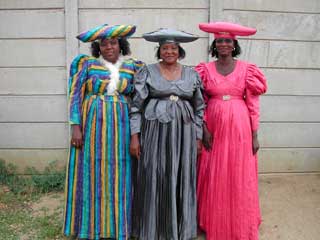
The Herero are a Bantu ethnic group inhabiting parts of Southern Africa. There were an estimated 250,000 Herero people in Namibia in 2013. They speak Otjiherero, a Bantu language. Though the Herero primarily reside in Namibia, there are also significant populations in Botswana and Angola. In Botswana, the Hereros or Ovaherero are mostly found in Maun and some villages surrounding Maun. These villages among others are Sepopa, Toromuja, Karee and Etsha. Some of them are at Mahalapye. In the South eastern part of Botswana they are at Pilane. There are also a few of them in the Kgalagadi South, that is Tsabong, Omawaneni, Draaihoek and Makopong Villages.

Herero is a Bantu language spoken by the Herero and Mbanderu peoples in Namibia and Botswana, as well as by small communities of people in southwestern Angola. There were 250,000 speakers in these countries between 2015 and 2018.

The Ovambo language is a dialect cluster spoken by the Ovambo people in southern Angola and northern Namibia, of which the written standards are Kwanyama and Ndonga.

The 250 or so "Narrow Bantu languages" are conventionally divided up into geographic zones first proposed by Malcolm Guthrie (1967–1971). These were assigned letters A–S and divided into decades ; individual languages were assigned unit numbers, and dialects further subdivided. This coding system has become the standard for identifying Bantu languages; it was the only practical way to distinguish many ambiguously named languages before the introduction of ISO 639-3 coding, and it continues to be widely used. Only Guthrie's Zone S is (sometimes) considered to be a genealogical group. Since Guthrie's time a Zone J has been set up as another possible genealogical group bordering the Great Lakes.
Tswa (Xitswa) is a South-Eastern Bantu language in Southern Mozambique. Its closest relatives are Ronga and Tsonga, the three forming the Tswa–Ronga family of languages.
Kwangali, or RuKwangali, is a Bantu language spoken by 85,000 people along the Kavango River in Namibia, where it is a national language, and in Angola. It is one of several Bantu languages of the Kavango which have click consonants; these are the dental clicks c and gc, along with prenasalization and aspiration.
Songe, also known as Songye, Kisonge, Lusonge, Yembe, and Northeast Luba, is a Bantu language spoken in the Democratic Republic of the Congo.
The Lomwe (Lowe) language, Elomwe, also known as Western Makua, is the fourth-largest language in Mozambique. It belongs with Makua in the group of distinctive Bantu languages in the northern part of the country: The Makhuwa-using area proper is separated by a large Lomwe-speaking area from the related eChuwabo, although eMakhuwa neighbours eChuwabo in a more coastal zone. To the south, the rather more distantly related Sena (ChiSena) should be assigned to a group with Nyanja and Chewa, while the distinct group which includes Yao, Makonde and Mwera is found to the north. Apart from the regional variations found within eMakhuwa proper, eLomwe uses ch where tt appears in eMakhuwa orthography: for instance eMakhuwa mirette ("remedy") corresponds to eLomwe mirecce, eMakhuwa murrutthu to eLomwe miruchu, eMakhuwa otthapa ("joy") to eLomwe ochapa.
The Kwisi are a seashore-fishing and hunter-gatherer people of southwest Angola that physically seem to be a remnant of an indigenous population—along with the Kwadi, the Cimba, and the Damara—that are unlike either the San (Bushmen) or the Bantu. Culturally they have been strongly influenced by the Kuvale, and speak the Kuvale dialect of Herero. There may, however, have been a few elderly speakers of an unattested Kwisi language in the 1960s.
The Kavango – Southwest Bantu languages are a group of Bantu languages established by Anita Pfouts (2003). The Southwest Bantu languages constitute most of Guthrie's Zone R. The languages, or clusters, along with their Guthrie identifications, are:
Luyana (Luyaana), also known as Luyi, is a Bantu language spoken in Zambia and perhaps in small numbers in neighboring countries. It appears to be an divergent lineage of Bantu. It is spoken by the Luyana people, a subgroup of the Lozi people.
Ding is a Bantu language that is spoken in the Democratic Republic of Congo.
Yans (Yanzi) is a Bantu language spoken in the Democratic Republic of the Congo by the Bayanzi.
The Nen language, Tunen (Banen), is a Bantu language of Cameroon. Maho (2009) considers Aling'a to be a distinct language. Unlike all other Bantu languages, Nen has an SOV word order rather than the standard Bantu SVO word order.
Zemba or Dhimba is a Bantu language spoken mainly in Angola where the language has about 18,000 speakers, and also in Namibia with some 7,000. It is closely related to Herero, and is often considered a dialect of that language, especially as the Zemba are ethnically Herero.
Samia (Saamia) is a Bantu language spoken by the Luhya people of Uganda and Kenya. Ethnologue includes Songa as a dialect, but it may be a separate language.
Kuvale is a Southern Bantu language spoken in Angola, in the middle of a large Umbundu-speaking area. It has traditionally been considered a dialect of Herero; however, Maho (2009) has moved it from Bantu Zone R.30 to Zone R.10, which includes Umbundu and a few smaller languages. Ngendelengo may be a distinct language.
Ikizu is a Bantu language spoken by the Ikizu peoples of Tanzania. Dialects are Ikizu proper and Sizaki. Maho (2009) treats Sizaki (Shashi) as a separate language. However, Ethnologue 16th edition retired the ISO code for Sizaki, merging it into Ikizu.
Simaa is a Bantu language of Zambia. It was assigned by Guthrie to Bantu group K.30, which Pfouts (2003) established as part of the Kavango–Southwest branch of Bantu. Though not specifically addressed, Simaa may be in that family as well.
Losengo (Lusengo) is a Bantu language spoken in the Democratic Republic of the Congo. It has had a significant effect on Lingala, the most important Bantu language in the two Congos.



